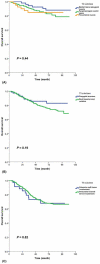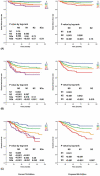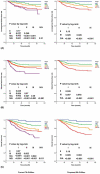Proposal for the 8th edition of the AJCC/UICC staging system for nasopharyngeal cancer in the era of intensity-modulated radiotherapy
- PMID: 26588425
- PMCID: PMC4968037
- DOI: 10.1002/cncr.29795
Proposal for the 8th edition of the AJCC/UICC staging system for nasopharyngeal cancer in the era of intensity-modulated radiotherapy
Abstract
Background: An accurate staging system is crucial for cancer management. Evaluations for continual suitability and improvement are needed as staging and treatment methods evolve.
Methods: This was a retrospective study of 1609 patients with nasopharyngeal carcinoma investigated by magnetic resonance imaging, staged with the 7th edition of the American Joint Committee on Cancer (AJCC)/International Union Against Cancer (UICC) staging system, and irradiated by intensity-modulated radiotherapy at 2 centers in Hong Kong and mainland China.
Results: Among the patients without other T3/T4 involvement, there were no significant differences in overall survival (OS) between medial pterygoid muscle (MP) ± lateral pterygoid muscle (LP), prevertebral muscle, and parapharyngeal space involvement. Patients with extensive soft tissue involvement beyond the aforementioned structures had poor OS similar to that of patients with intracranial extension and/or cranial nerve palsy. Only 2% of the patients had lymph nodes > 6 cm above the supraclavicular fossa (SCF), and their outcomes resembled the outcomes of those with low extension. Replacing SCF with the lower neck (extension below the caudal border of the cricoid cartilage) did not affect the hazard distinction between different N categories. With the proposed T and N categories, there were no significant differences in outcome between T4N0-2 and T1-4N3 disease.
Conclusions: After a review by AJCC/UICC preparatory committees, the changes recommended for the 8th edition include changing MP/LP involvement from T4 to T2, adding prevertebral muscle involvement as T2, replacing SCF with the lower neck and merging this with a maximum nodal diameter > 6 cm as N3, and merging T4 and N3 as stage IVA criteria. These changes will lead not only to a better distinction of hazards between adjacent stages/categories but also to optimal balance in clinical practicability and global applicability.
Keywords: TNM staging system; nasopharyngeal cancer; prognostication.
© 2015 American Cancer Society.
Figures





References
-
- Fleming ID, Cooper JS, Henson DE, et al., editors. AJCC Cancer Staging Manual. 5th Lippincott-Raven; Philadelphia, PA: 1997.
-
- Sobin LH, Wittekind CH, editors. TNM Classification of Malignant Tumours. 5th Wiley-Liss; New York, NY: 1997.
-
- Ho JHC. Stage classification of nasopharyngeal carcinoma: a review. In: de The G, Ito Y, editors. Nasopharyngeal Carcinoma: Etiology and Control. International Agency for Research on Cancer; Lyon, France: 1978. pp. 99–113.
-
- Lee AW, Foo W, Law SC, et al. Staging of nasopharyngeal carcinoma: from Ho’s to the new UICC system. Int J Cancer. 1999;84:179–187. - PubMed
-
- Greene F, Page D, Fleming I, editors. AJCC Cancer Staging Manual. 6th Springer-Verlag; New York, NY: 2002.
MeSH terms
Substances
Grants and funding
LinkOut - more resources
Full Text Sources
Other Literature Sources
Medical

